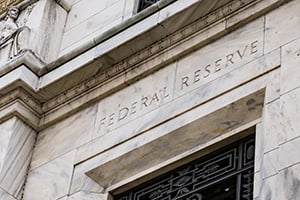 The Federal Open Market Committee (FOMC) met this week and voted unanimously to hold rates steady for the second consecutive meeting. This leaves its policy range at 5.25 percent to 5.5 percent. After a historic run where the committee increased that range by 5.25 percent over the course of 11 meetings, no change can certainly feel like a change. So, what are the driving forces behind the continued pause? Let’s look at some of the details the FOMC is keeping its eyes on, as well as what we should be paying attention to moving forward.
The Federal Open Market Committee (FOMC) met this week and voted unanimously to hold rates steady for the second consecutive meeting. This leaves its policy range at 5.25 percent to 5.5 percent. After a historic run where the committee increased that range by 5.25 percent over the course of 11 meetings, no change can certainly feel like a change. So, what are the driving forces behind the continued pause? Let’s look at some of the details the FOMC is keeping its eyes on, as well as what we should be paying attention to moving forward.
The Fed’s Balancing Act
Echoing comments from his previous post-meeting press conference, Fed Chair Jerome Powell emphasized that the committee is in a position to move forward with caution as it continues to assess incoming data. “In light of the uncertainties and risks, and how far we have come, the committee is proceeding carefully. We will continue to make our decisions meeting by meeting based on the totality of the incoming data and their implications for the outlook for economic activity and inflation, as well as the balance of risks.”
The committee believes its existing policy is well within restrictive territory and is already seeing signs that its tightening campaign is making notable progress. Inflation has been coming down, unemployment has been inching upward, and credit availability continues to dry up. Still, very real risks remain, and it is yet to be seen if these promising trends are sustainable.
Third-quarter GDP growth far surpassed economist expectations, consumer spending has been robust, and unemployment remains near historical lows. Altogether, these items can paint a picture of an economy firing on all cylinders. With such strong economic activity, the looming risk is that conditions remain too hot and fuel a rebound in inflation (i.e., the Fed’s worst nightmare). As the balancing act continues, the FOMC has taken a step back to see how things develop and allow the full effects of its existing rate increases to continue developing.
Rate Hikes Ahead?
As for what lies ahead, Powell made it clear that there is still work to be done, and the Fed is not taking future rate hikes off the table. “Evidence of growth consistently above potential, or that tightness in the labor market is no longer easing, could put further progress on inflation at risk and could warrant further tightening of monetary policy.”
As of this writing (November 1), markets are only pricing in a roughly 20 percent chance of a rate increase at the December FOMC meeting, but there is still plenty of time for conditions to further evolve. October unemployment data will be announced at the end of this week, and surveyed economists anticipate the unemployment rate will hold steady at 3.8 percent. Even so, evidence suggests that the supply-and-demand conditions within the labor market are coming more into balance over time, a positive development from the Fed’s perspective. The next inflation report will be released November 14, and committee members will undoubtedly be looking for continued softening in consumer price pressures.
We’ll have to wait a bit longer for insight into fourth-quarter GDP results, but consensus expectations point to a significant slowdown relative to the recent blowout quarter. If price pressures continue to ease, the labor market remains in check, and economic activity shows signs of cooling, the Fed will likely feel validated in its decision to keep rates unchanged this month. If those things don’t come together? Another rate hike is still on the table for December’s meeting.
Stay Tuned
Ultimately, the FOMC’s data dependency means we’ll be keeping tabs on changing conditions, and we plan to continue these post-meeting blogs. Be sure to subscribe to The Independent Market Observer so you don’t miss a beat. The next FOMC meeting is scheduled for December 13–14, and we’ll be here to help you digest what we’re being . . . fed.


 Print
Print

